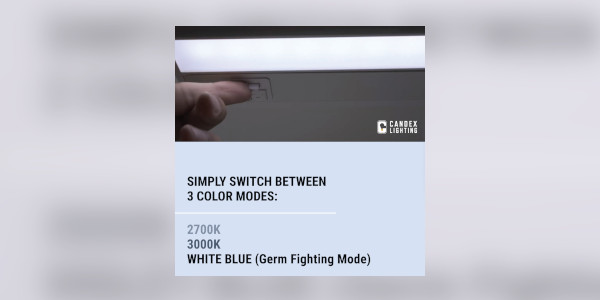Introducing a new form of antibacterial lights that destroy bacteria – Candex Antibacterial LED Series. Candex has combined the best of microbiology and lighting technology into the new Antibacterial LED Series in light bulbs, downlights, and under cabinet lights. Reducing and eliminating up to 99% of germs from the air and surfaces, this is the best option to create a safe and healthier environment for your family and coworkers.
To switch between warm white 3000K and germ fighting violet-blue light mode, simply toggle on/off with Candex Antibacterial LED A19, BR30, and downlights. The Antibacterial Under Cabinet Lights come with installed preset on/off and 3CCT-Select, including the white-blue disinfecting mode.
What Does the Light Protect Against?Both VBL and white blue mode eliminate germs, bacteria, fungi, mold and spores from the air and surfaces. VBL prevents: E.Coli: causes 265,000 illnesses per year in the US; Salmonella: causes 26,500 hospitalizations/420 deaths in the US every year; MRSA: causes 120,000 cases/20,000 deaths in the US in 2017; Staphylococcus Aureus: causes more than 119,000 people to suffer in the US in 2017.
What is Violet Blue Light (VBL)? Research has shown that VBL is a visible light, out of ultraviolet (UV) spectrum, ranges from 400nm – 420nm wavelength. In fact, we are exposed to VBL everyday under the sun. Unlike UV lights, VBL is harmless and has scientifically been proven to be safe from both human skin, eyes, and pets.
VBL is intrinsically antimicrobial attributed to the presence of the endogenous photosensitizing chromospheres (i.e., photosensitizers) in microbial cells. The endogenous photosensitizers absorb violet blue light and subsequently lead to the production of cytotoxic reactive oxygen species (ROS) that can kill microbes.
The endogenous photosensitizers, including porphyrins, flavins, and NADH, were successfully identified in some important microbial cells. Studies also provided evidence that VBL inactivation of microbes was attributed to ROS-induced cell membrane damage, inactivation of virulence factors, DNA-oxidation, genetic changes, etc.
Endogenous porphyrins (ordinarily present in bacterial cell walls) after absorbing VBL at 400 – 420nm wavelength, lead to highly cytotoxic ROS production that kills bacteria.
How the Light Works: 1. Once the VBL mode is switched on, VBL at 400nm – 420nm wavelength is cast on to the Endogenous porphyrins ordinarily present in bacterial cell walls. 2.After 3-5 hours, ROS are produced around bacterial cell walls after a chemical reaction between endogenous porphyrins and the violet blue light.3.ROS starts to tear the bacteria cell wall apart leading to the damages of bacterial DNA, RNA, and proteins, and causes bacterial cell death. 4. Turn on violet blue light minimum 4 hours per day to effectively inactivate microbes in the air or on the surface (decontamination) 4 feet away from the light source or 2 consecutive day of 3 hours of operations.
Safety from Candex Antibacterial LED series: Candex Antibacterial Lights have passed the IEC 62471 tests performed by UL/ETL labs; The IEC 62471 Standard is intended to address potential photobiological safety concerns from LEDs by providing a method for categorizing the potential risk to the eyes and skin; Protect people from injuries and blindness caused by exposure to UV, visible, and infrared/thermal electromagnetic radiation.
If you have any questions about Candex Antibacterial LED lighting technologies, please visit Candex at: www.candexlighting.com.







